- Accueil
- Pages cachées
- 24 MAI 2024 NEWS
24 MAI 2024 NEWS
INSTITUT SUPERIEUR INSTITUT SUPERIEUR D'ANTHROPOLOGIE
INSTITUT OF ANTHROPOLOGY
COURS ONLINE – COURS A DISTANCE
INSCRIPTIONS OUVERTES
REGISTER NOW
KURDISTAN – 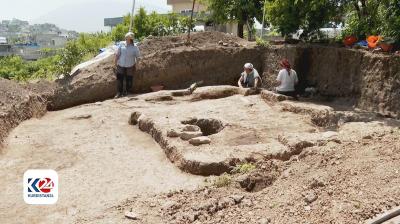 Saran - A joint team from the University of Barcelona, Salahaddin University, and the Soran Archaeology Directorate has been excavating the Banahilk archaeological site in the center of Soran town for the past six years.The project aims to uncover archaeological remains that could date back 7,000 years,spanning four differente ras of human history. Professor Ana Gomez from the University of Barcelona explained the significance of theirfindings: “Six years ago, we had the opportunity to start working here. The houses are made of mud in circular shapes, with painted dishes, cooking utensils, and animal bones. This is important because it indicates their ability to bring and distribute items from abroad.” The team has discovered animal bones in pots with various carbon layers and carvings with different shapes and stories. The Kurdistan Region boasts 5,000 archaeological sites, with 1,200 registered in the Soran Independent Administration. Abdulwahhab Sulaiman, director of Soran archaeology, highlighted the architectural advancements of the region's ancient inhabitants: “The shape of the houses in the Halaf period was circular or T-shaped, but here all the houses are angular and rectangular, showing that the people who lived in Kurdistan were very advanced in terms of architecture.” The Banahilk site was initially excavated in the late 1940s by archaeologists from the University of Chicago, who found remains from the Halaf culture during a brief 10-day dig. Now, after six years of continuous work, archaeologists have uncovered remains from four distinct periods: the Halaf, Chalcolithic, Bronze, and Islamic eras. In 2018, a team of researchers from the University of Cambridge embarked on an excavation expedition to Shanidar Cave in the Kurdistan Region, a site renowned for its significance in Neanderthal research. The unveiling of the reconstructed face of a 75,000-year-old Neanderthal woman, Shanidar Z, has sparked international interest and ignited discussions about human evolution, cultural practices, and the interactions between Neanderthals and modern humans. In a groundbreaking revelation, the University of Cambridge has unveiled the reconstructed face of a Neanderthal woman named Shanidar Z, shedding new light on the lives and behaviors of our ancient ancestors.
Saran - A joint team from the University of Barcelona, Salahaddin University, and the Soran Archaeology Directorate has been excavating the Banahilk archaeological site in the center of Soran town for the past six years.The project aims to uncover archaeological remains that could date back 7,000 years,spanning four differente ras of human history. Professor Ana Gomez from the University of Barcelona explained the significance of theirfindings: “Six years ago, we had the opportunity to start working here. The houses are made of mud in circular shapes, with painted dishes, cooking utensils, and animal bones. This is important because it indicates their ability to bring and distribute items from abroad.” The team has discovered animal bones in pots with various carbon layers and carvings with different shapes and stories. The Kurdistan Region boasts 5,000 archaeological sites, with 1,200 registered in the Soran Independent Administration. Abdulwahhab Sulaiman, director of Soran archaeology, highlighted the architectural advancements of the region's ancient inhabitants: “The shape of the houses in the Halaf period was circular or T-shaped, but here all the houses are angular and rectangular, showing that the people who lived in Kurdistan were very advanced in terms of architecture.” The Banahilk site was initially excavated in the late 1940s by archaeologists from the University of Chicago, who found remains from the Halaf culture during a brief 10-day dig. Now, after six years of continuous work, archaeologists have uncovered remains from four distinct periods: the Halaf, Chalcolithic, Bronze, and Islamic eras. In 2018, a team of researchers from the University of Cambridge embarked on an excavation expedition to Shanidar Cave in the Kurdistan Region, a site renowned for its significance in Neanderthal research. The unveiling of the reconstructed face of a 75,000-year-old Neanderthal woman, Shanidar Z, has sparked international interest and ignited discussions about human evolution, cultural practices, and the interactions between Neanderthals and modern humans. In a groundbreaking revelation, the University of Cambridge has unveiled the reconstructed face of a Neanderthal woman named Shanidar Z, shedding new light on the lives and behaviors of our ancient ancestors.
Joint archaeological team uncovers 7,000-Year-Old remains in Soran (kurdistan24.net)
BELGIQUE – 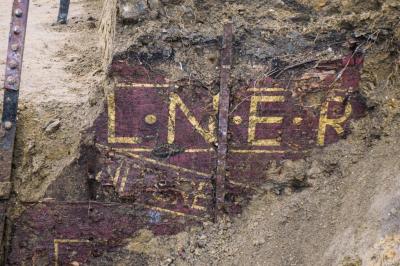 Antwerp - Researchers from the Urban Archeology Department of the City of Antwerp were excavating an area underneath the wall of a 19th-century fortress known as the Old Citadel as part of their “Oosterweel Link” project, when they stumbled upon the remains of a 100-year-old storage wagon from Great Britain. The wooden wagon was in a poor state. Deteriorating rapidly after excavation, its only identifiable features were a set of inscriptions reading “FURNITURE REMOVAL TO HOUSE,” “Enquire at any station,” “BK769,” and “LNER.” LNER stands for London North Eastern Railway, a British train operating company headquartered more than 500 miles away in the city of York. The company was founded in 1923 as part of the 1921 Railways Act. Also known as the Grouping Act, the piece of legislation consolidated the country’s 120 independent railway companies and their combined 20,000 miles of track into four larger, hopefully more profitable corporations known as the “Big Four.”
Antwerp - Researchers from the Urban Archeology Department of the City of Antwerp were excavating an area underneath the wall of a 19th-century fortress known as the Old Citadel as part of their “Oosterweel Link” project, when they stumbled upon the remains of a 100-year-old storage wagon from Great Britain. The wooden wagon was in a poor state. Deteriorating rapidly after excavation, its only identifiable features were a set of inscriptions reading “FURNITURE REMOVAL TO HOUSE,” “Enquire at any station,” “BK769,” and “LNER.” LNER stands for London North Eastern Railway, a British train operating company headquartered more than 500 miles away in the city of York. The company was founded in 1923 as part of the 1921 Railways Act. Also known as the Grouping Act, the piece of legislation consolidated the country’s 120 independent railway companies and their combined 20,000 miles of track into four larger, hopefully more profitable corporations known as the “Big Four.”
A Century-Old U.K. Train Car Mysteriously Turns Up Under a Belgian Citadel (artnet.com)
CHINE –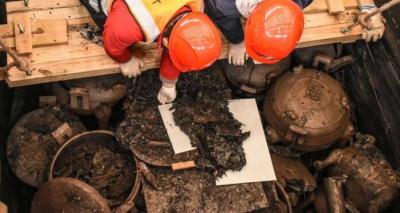 Chu - In mid-April, Chinese archaeologists announced they had completed the first stage of excavations on a kingly tomb believed to date back 2,200 years to the state of Chu. An integral part of fledgling Chinese history, Chu was a powerful kingdom that once conquered and annexed the state where Confucius was born, and the archaeologists believe they know exactly who it is that’s buried inside. Located in the eastern province of Anhui, work at the tomb began in 2019 because reports had found it was a common target of looters. Excavations have shown it to be the most complex funerary structure from its time ever discovered in China. Over 3,000 relics, including lacquered wood products, bronze vessels, figurines, chariot and horse pits, and sacrificial remains were all found in addition to a woven bamboo mat that allowed scientists to get a radiocarbon analysis that showed the tomb’s age. “At present, the on-site work has entered the second stage within the coffin chamber, that is, the excavation and cleaning of the interior of the coffin chamber,” Gong Xicheng, deputy director of the Anhui Provincial Institute of Cultural Relics and Archaeology, told Xinhua. “Perhaps by then, the identity of the tomb owner will be revealed and the mystery can be solved.”
Chu - In mid-April, Chinese archaeologists announced they had completed the first stage of excavations on a kingly tomb believed to date back 2,200 years to the state of Chu. An integral part of fledgling Chinese history, Chu was a powerful kingdom that once conquered and annexed the state where Confucius was born, and the archaeologists believe they know exactly who it is that’s buried inside. Located in the eastern province of Anhui, work at the tomb began in 2019 because reports had found it was a common target of looters. Excavations have shown it to be the most complex funerary structure from its time ever discovered in China. Over 3,000 relics, including lacquered wood products, bronze vessels, figurines, chariot and horse pits, and sacrificial remains were all found in addition to a woven bamboo mat that allowed scientists to get a radiocarbon analysis that showed the tomb’s age. “At present, the on-site work has entered the second stage within the coffin chamber, that is, the excavation and cleaning of the interior of the coffin chamber,” Gong Xicheng, deputy director of the Anhui Provincial Institute of Cultural Relics and Archaeology, told Xinhua. “Perhaps by then, the identity of the tomb owner will be revealed and the mystery can be solved.”
TURQUIE – 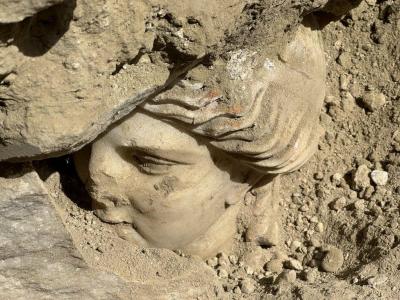 Laodikeia - A 2100-year-old statue head of the Hygieia (Health) Goddess was found during the excavations in the ancient city of Laodikeia in Pamukkale, Denizli, southwestern Türkiye. Earthquakes often plagued the town, and in 494 AD, a massive quake severely crippled the city. A further earthquake between 602-610 and an increasing threat from Arab raids led to the eventual abandonment of the city. Hygeia was the ancient Greek goddess of health. She gave her name to the philosophy of hygiene. Hygeia was a young goddess, daughter and chief attendant to Asklepios, the god of medicine. She was in charge of cleanliness and how to live a long life (preventive medicine).
Laodikeia - A 2100-year-old statue head of the Hygieia (Health) Goddess was found during the excavations in the ancient city of Laodikeia in Pamukkale, Denizli, southwestern Türkiye. Earthquakes often plagued the town, and in 494 AD, a massive quake severely crippled the city. A further earthquake between 602-610 and an increasing threat from Arab raids led to the eventual abandonment of the city. Hygeia was the ancient Greek goddess of health. She gave her name to the philosophy of hygiene. Hygeia was a young goddess, daughter and chief attendant to Asklepios, the god of medicine. She was in charge of cleanliness and how to live a long life (preventive medicine).
USA – 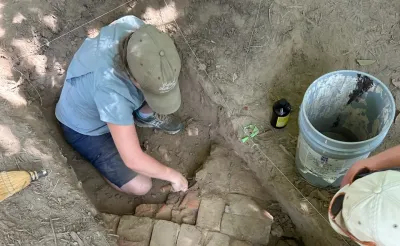 Williamsburg - Colonial Williamsburg archeologists unearthed what they believe to be the site of a Revolutionary War barracks in 2023. The discovery marks the first opportunity to study structures made specifically to house Continental soldiers in Williamsburg. The dig began to ensure construction of the city’s planned indoor sports facility did not disturb any historic artifacts. The plans for that facility have since moved to preserve the site. “When the planning for the sports complex began, we began doing our work which required looking at historic documentation which revealed to us something that we kind of had in the back of our minds, which is that this area over by our visitor center was designated on historic maps to be the location of a barracks constructed in 1776,” Colonial Williamsburg’s Executive Director of Archeology Jack Gary said. Archeologists discovered the site when digging uncovered intact chimney bases that matched historic maps of the 18th century barracks. The barracks were constructed to house up to 2,000 men and 100 horses and are believed to have been burned down by British forces led by Gen. Cornwallis in 1781. Excavation unveiled what appears to be multiple housing structures as well as military artifacts and personal effects from both officers and enlisted men. These items ranged from clay tobacco pipes and a mother-of-pearl button inlay to gun hardware and lead shot bearing the tooth marks of soldiers. “Because we've preserved the site, a point of research in the future is to be able to delineate each of the individual buildings and get an idea of what they were used for,” Gary said. “Can we find the support structures such as the stables, there may have even been other support structures like a large kitchen or bake ovens to be able to feed everybody.” Gary said further excavation work is on hold until after the sports facility construction wraps. He is hopeful that the project can work in partnership with the sports facility to showcase their work and the history of the site to visitors. “There will be thousands of kids and families coming through this facility and we’ll be able to be doing our work right there and interact with them,” said Gary. “It’s an opportunity for us, too, to not just do this work kind of behind the scenes.” Gary said 2026 would be an ideal time to begin the next phase of research to line up with the 250th anniversary of the barracks’ construction. While it is too early to say exactly how Colonial Williamsburg will showcase the site, Gary said they are thinking about possibilities. “There has been some brainstorming about turning the area into a park associated with the sports complex that would be dedicated to exhibiting some aspect of the barracks as opposed to excavating it and then just leaving it or not talking about it.”
Williamsburg - Colonial Williamsburg archeologists unearthed what they believe to be the site of a Revolutionary War barracks in 2023. The discovery marks the first opportunity to study structures made specifically to house Continental soldiers in Williamsburg. The dig began to ensure construction of the city’s planned indoor sports facility did not disturb any historic artifacts. The plans for that facility have since moved to preserve the site. “When the planning for the sports complex began, we began doing our work which required looking at historic documentation which revealed to us something that we kind of had in the back of our minds, which is that this area over by our visitor center was designated on historic maps to be the location of a barracks constructed in 1776,” Colonial Williamsburg’s Executive Director of Archeology Jack Gary said. Archeologists discovered the site when digging uncovered intact chimney bases that matched historic maps of the 18th century barracks. The barracks were constructed to house up to 2,000 men and 100 horses and are believed to have been burned down by British forces led by Gen. Cornwallis in 1781. Excavation unveiled what appears to be multiple housing structures as well as military artifacts and personal effects from both officers and enlisted men. These items ranged from clay tobacco pipes and a mother-of-pearl button inlay to gun hardware and lead shot bearing the tooth marks of soldiers. “Because we've preserved the site, a point of research in the future is to be able to delineate each of the individual buildings and get an idea of what they were used for,” Gary said. “Can we find the support structures such as the stables, there may have even been other support structures like a large kitchen or bake ovens to be able to feed everybody.” Gary said further excavation work is on hold until after the sports facility construction wraps. He is hopeful that the project can work in partnership with the sports facility to showcase their work and the history of the site to visitors. “There will be thousands of kids and families coming through this facility and we’ll be able to be doing our work right there and interact with them,” said Gary. “It’s an opportunity for us, too, to not just do this work kind of behind the scenes.” Gary said 2026 would be an ideal time to begin the next phase of research to line up with the 250th anniversary of the barracks’ construction. While it is too early to say exactly how Colonial Williamsburg will showcase the site, Gary said they are thinking about possibilities. “There has been some brainstorming about turning the area into a park associated with the sports complex that would be dedicated to exhibiting some aspect of the barracks as opposed to excavating it and then just leaving it or not talking about it.”
Williamsburg archeologists unearth site of Revolutionary War barracks (whro.org)
CHINE – 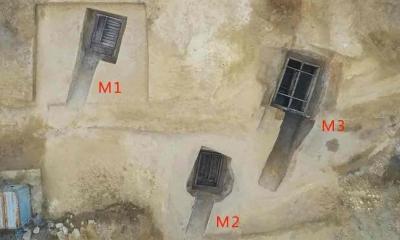
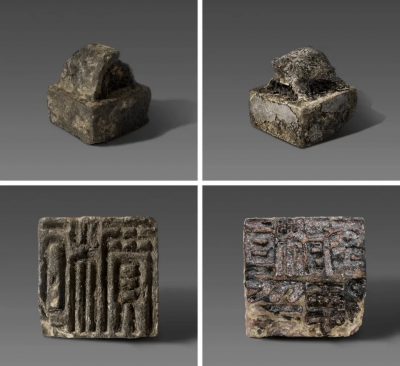
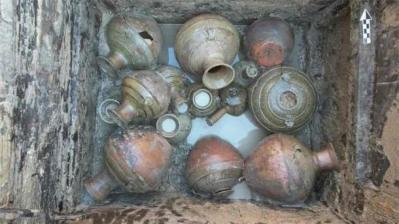 Rizhao - Archaeologists discovered three remarkable 1,800-year-old, residential-style tombs featuring rooms and windows, where a wealthy family was laid to rest alongside their treasured possessions, in Rizhao, China. The tombs are thought to date to the Han Dynasty, which ruled China between 206 B.C. and A.D. 220—what is considered to be a golden age in Chinese history. The tombs, which are from the Han dynasty, were discovered by archaeologists in Rizhao, China, while they were getting ready for a park expansion. But the archaeologists weren’t actually the first to find the tombs; looters had previously discovered at least portions of them at some point, largely clearing out two of the tombs, while leaving the third relatively undisturbed. According to a statement translated from the Institute of Archaeology of the Chinese Academy of Social Sciences, apart from the 70 artifacts constituting the family treasure in the third tomb, it is the tomb design that makes the tombs so fascinating. These are residential-style tombs, featuring doors and windows, with one containing multiple interconnecting rooms. Two of the tombs contained inscriptions of the Huan surname, showing the distinct familial connection between them. Also, a bronze seal found in the tomb bears the name “Huan Jia”—revealing the identity of the owner. Experts say the tombs, accessed through passageways, share a similar design. The most intact tomb, known as M3, includes interconnected rooms with wooden windows and doors, suggesting it may have been the final resting place of a married couple. The third tomb, known as M3 and believed to contain a married couple, had all its treasures intact. This tomb consisted of two rooms connect by a doorway. The miniature wooden doors and windows in this tomb that linked the two rooms were supposed to imitate a residential style, according to archaeologists. The 70 artifacts recovered from the tomb complex so far suggest that this was a high-status, wealthy family. These include an iron sword, bronze mirrors, and a variety of pottery. In a distinctly unusual discovery, the team also located pieces of a coffin carriage, which was used to transport coffins into the tomb. The archaeologists described it as “exquisitely crafted and an uncommon find.” Moreover, it is extremely uncommon to discover a family name connecting the tombs. The basic design of the tombs is also the same, with a sloping entrance tunnel that leads to each chamber located deep within the mound. Brick-carved arches, doors, and windows played heavily, and murals featured flora patterns and figures.
Rizhao - Archaeologists discovered three remarkable 1,800-year-old, residential-style tombs featuring rooms and windows, where a wealthy family was laid to rest alongside their treasured possessions, in Rizhao, China. The tombs are thought to date to the Han Dynasty, which ruled China between 206 B.C. and A.D. 220—what is considered to be a golden age in Chinese history. The tombs, which are from the Han dynasty, were discovered by archaeologists in Rizhao, China, while they were getting ready for a park expansion. But the archaeologists weren’t actually the first to find the tombs; looters had previously discovered at least portions of them at some point, largely clearing out two of the tombs, while leaving the third relatively undisturbed. According to a statement translated from the Institute of Archaeology of the Chinese Academy of Social Sciences, apart from the 70 artifacts constituting the family treasure in the third tomb, it is the tomb design that makes the tombs so fascinating. These are residential-style tombs, featuring doors and windows, with one containing multiple interconnecting rooms. Two of the tombs contained inscriptions of the Huan surname, showing the distinct familial connection between them. Also, a bronze seal found in the tomb bears the name “Huan Jia”—revealing the identity of the owner. Experts say the tombs, accessed through passageways, share a similar design. The most intact tomb, known as M3, includes interconnected rooms with wooden windows and doors, suggesting it may have been the final resting place of a married couple. The third tomb, known as M3 and believed to contain a married couple, had all its treasures intact. This tomb consisted of two rooms connect by a doorway. The miniature wooden doors and windows in this tomb that linked the two rooms were supposed to imitate a residential style, according to archaeologists. The 70 artifacts recovered from the tomb complex so far suggest that this was a high-status, wealthy family. These include an iron sword, bronze mirrors, and a variety of pottery. In a distinctly unusual discovery, the team also located pieces of a coffin carriage, which was used to transport coffins into the tomb. The archaeologists described it as “exquisitely crafted and an uncommon find.” Moreover, it is extremely uncommon to discover a family name connecting the tombs. The basic design of the tombs is also the same, with a sloping entrance tunnel that leads to each chamber located deep within the mound. Brick-carved arches, doors, and windows played heavily, and murals featured flora patterns and figures.
USA – 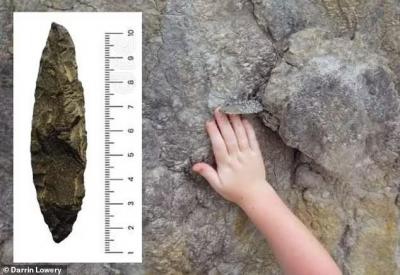 Maryland - When and how humans first settled in the Americas is a subject of considerable controversy. A Smithsonian Institution geologist now thinks he has discovered fresh evidence in Maryland that might change the course of the country’s history. Darrin Lowery discovered 286 artifacts in the Chesapeake Bay, with the oldest embedded in charcoal that dated back more than 22,000 – at least 7,000 years earlier than what scientists believe was when people initially populated America. Archaeological finds in New Mexico’s White Sands National Park, according to multiple researchers, date human activity to between 21,000 and 23,000 years ago. Lowery now believes that humans existed in Maryland around the same time. Lowery and his team have been excavating Parsons Island for over a decade, finding ancient stone tools in layers of sediment that were dated by studying preserved pollen and microfossils. Following a non-peer-reviewed publication of his findings—Lowery told the Washington Post that “life’s too short” to debate with other experts over the peer-review process—he claims that the oldest of 286 artifacts found on Parsons Island significantly pushes back the date of human arrival in the area.
Maryland - When and how humans first settled in the Americas is a subject of considerable controversy. A Smithsonian Institution geologist now thinks he has discovered fresh evidence in Maryland that might change the course of the country’s history. Darrin Lowery discovered 286 artifacts in the Chesapeake Bay, with the oldest embedded in charcoal that dated back more than 22,000 – at least 7,000 years earlier than what scientists believe was when people initially populated America. Archaeological finds in New Mexico’s White Sands National Park, according to multiple researchers, date human activity to between 21,000 and 23,000 years ago. Lowery now believes that humans existed in Maryland around the same time. Lowery and his team have been excavating Parsons Island for over a decade, finding ancient stone tools in layers of sediment that were dated by studying preserved pollen and microfossils. Following a non-peer-reviewed publication of his findings—Lowery told the Washington Post that “life’s too short” to debate with other experts over the peer-review process—he claims that the oldest of 286 artifacts found on Parsons Island significantly pushes back the date of human arrival in the area.
ISRAEL – 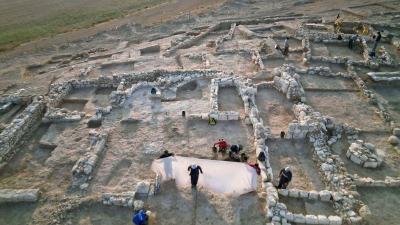 Rahat - Archaeologists from the Israel Antiquities Authority have discovered a Byzantine-period church in the northern Negev desert with wall art displaying ships. The surprise findings were announced in a press release issued by the authority on May 23. The discovery was made in the south of the Bedouin city of Rahat, where the Israel Antiquities Authority has been conducting excavations for several years in the context of a city expansion project. The excavated site tells the story of settlement in the northern Negev desert at the end of the Byzantine period and in the beginning of the early Islamic period. According to the excavators, “these intriguing drawings may have been left by Christian pilgrims arriving by ship to the Gaza port; their first inland stop was this Rahat church, continuing from here to other sites throughout the country.” This site, in fact, lies only a half-day’s walk from the ancient port of Gaza, and the church is located along an ancient Roman road that led from the coast to Beer Sheva, the Negev’s main city. According to the excavation directors — Dr. Oren Shmueli, Dr. Elena Kogan-Zehavi, and Dr. Noé David Michael on behalf of the Israel Antiquities Authority, together with Professor Deborah Cvikel of the University of Haifa’s Department of Maritime Civilizations — it is reasonable to think that Christian pilgrims traveled this road to reach the Christian holy places in Jerusalem and Bethlehem and the monasteries in the Negev hills and in the Sinai. “It is reasonable that their first stop after alighting from the ships in Gaza port was this very church revealed in our excavations south of Rahat,” the scholars said. The ships drawn on the rock “are a greeting from Christian pilgrims arriving by ship to Gaza port,” the excavation directors said. “Pilgrims [who] visited the church left their personal mark in the form of ship drawings on its walls. The ship is indeed an old Christian symbol, but in this case, apparently, it is a true graphical depiction of real ships in which the pilgrims traveled to the Holy Land.” Cvikel described one of the drawings: “One of the ships is depicted as a line drawing, but yet it may be discerned that its bow is slightly pointed and that there are oars on both sides of the vessel. This may be an aerial depiction of the ship, though it seems the artist was attempting a three-dimensional drawing. It may be that the lines below it portray the path beaten by the oars through the water.” “Ships or crosses left by visiting Christian pilgrims as witness to their visit are also found in Jerusalem’s Holy Sepulcher Church,” she added, highlighting a common practice of the pilgrims at that time. The reference is probably to the famous ship of the “Domine Ivimus,” the only image of a vessel found at the Holy Sepulcher (while the crosses are countless). It’s a charcoal drawing, dating between the second and fourth centuries, found on a stone used in a very ancient wall located in the foundation area of the basilica, in the part that is owned by the Armenians. “This surprising and intriguing find of ship drawings in a northern Negev Byzantine-period church opens a window for us to the world of Christian pilgrims visiting the Holy Land 1,500 years ago,” Israel Antiquities Authority Director Eli Escusido said. “It also provides firsthand evidence about the ships they traveled in and the maritime world of that time.”
Rahat - Archaeologists from the Israel Antiquities Authority have discovered a Byzantine-period church in the northern Negev desert with wall art displaying ships. The surprise findings were announced in a press release issued by the authority on May 23. The discovery was made in the south of the Bedouin city of Rahat, where the Israel Antiquities Authority has been conducting excavations for several years in the context of a city expansion project. The excavated site tells the story of settlement in the northern Negev desert at the end of the Byzantine period and in the beginning of the early Islamic period. According to the excavators, “these intriguing drawings may have been left by Christian pilgrims arriving by ship to the Gaza port; their first inland stop was this Rahat church, continuing from here to other sites throughout the country.” This site, in fact, lies only a half-day’s walk from the ancient port of Gaza, and the church is located along an ancient Roman road that led from the coast to Beer Sheva, the Negev’s main city. According to the excavation directors — Dr. Oren Shmueli, Dr. Elena Kogan-Zehavi, and Dr. Noé David Michael on behalf of the Israel Antiquities Authority, together with Professor Deborah Cvikel of the University of Haifa’s Department of Maritime Civilizations — it is reasonable to think that Christian pilgrims traveled this road to reach the Christian holy places in Jerusalem and Bethlehem and the monasteries in the Negev hills and in the Sinai. “It is reasonable that their first stop after alighting from the ships in Gaza port was this very church revealed in our excavations south of Rahat,” the scholars said. The ships drawn on the rock “are a greeting from Christian pilgrims arriving by ship to Gaza port,” the excavation directors said. “Pilgrims [who] visited the church left their personal mark in the form of ship drawings on its walls. The ship is indeed an old Christian symbol, but in this case, apparently, it is a true graphical depiction of real ships in which the pilgrims traveled to the Holy Land.” Cvikel described one of the drawings: “One of the ships is depicted as a line drawing, but yet it may be discerned that its bow is slightly pointed and that there are oars on both sides of the vessel. This may be an aerial depiction of the ship, though it seems the artist was attempting a three-dimensional drawing. It may be that the lines below it portray the path beaten by the oars through the water.” “Ships or crosses left by visiting Christian pilgrims as witness to their visit are also found in Jerusalem’s Holy Sepulcher Church,” she added, highlighting a common practice of the pilgrims at that time. The reference is probably to the famous ship of the “Domine Ivimus,” the only image of a vessel found at the Holy Sepulcher (while the crosses are countless). It’s a charcoal drawing, dating between the second and fourth centuries, found on a stone used in a very ancient wall located in the foundation area of the basilica, in the part that is owned by the Armenians. “This surprising and intriguing find of ship drawings in a northern Negev Byzantine-period church opens a window for us to the world of Christian pilgrims visiting the Holy Land 1,500 years ago,” Israel Antiquities Authority Director Eli Escusido said. “It also provides firsthand evidence about the ships they traveled in and the maritime world of that time.”
